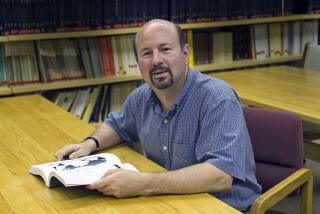Stephen H. Schneider dies at 65; Stanford expert on climate change
Stephen H. Schneider, a Stanford University biologist on the vanguard of climate-change research for four decades, who argued eloquently on human culpability in global warming and willingly threw himself into the political fray to explain and defend the scientific evidence, has died. He was 65.
Schneider had a heart attack Monday while flying to London from a science meeting in Stockholm, according to Stanford spokesman Dan Stober.
“Steve Schneider helped the world understand that the burning of fossils had altered the chemistry of Earth’s atmosphere, and that this change … had led to a discernible human influence on our planet’s climate,” said Benjamin D. Santer, a leading climate researcher at Lawrence Livermore National Laboratory, who described his colleague as the Carl Sagan of climate science.
Santer and Schneider were among the scientists who served on the international panel that shared the 2007 Nobel Peace Prize with former Vice President Al Gore, who in a statement Monday called Schneider a “prolific researcher and author … and a wonderful communicator” whose contributions to the advancement of climate science will be “sorely missed.”
Schneider, the winner of a 1992 MacArthur grant, was a leading member of the United Nations’ Intergovernmental Panel on Climate Change, established in 1989 to investigate climate change and its effects. A Stanford professor since 1992, he wrote several influential books on climate change, including “The Genesis Strategy” (1976), “The Coevolution of Climate and Life” (1984) and “Global Warming” (1989).
He testified frequently before Congress, most recently in May when he appeared before the House Select Committee on Energy Independence and Global Warming to decry harassment of climate-change researchers by skeptics.
He said he had received hundreds of abusive e-mails from critics, particularly since the Copenhagen climate change summit in December. A few weeks ago he told the London Guardian newspaper that his name was among those of several climatologists that appeared earlier this year on a death list on a neo-Nazi website.
Despite the threats, he continued to speak out in public and urged fellow scientists to do the same. He maintained a Web page, Mediarology, that advised scientists on how to present their views credibly and effectively.
“In my view, staying out of the fray is not taking the ‘high ground’; it is just passing the buck,” he wrote.
Santer, who knew Schneider for more than 25 years, said one of his most enduring memories of his colleague was an encounter with a skeptic at a 1995 meeting of the United Nations climate change panel. A delegate from Kenya had attacked a chapter of the panel’s report written by Santer, arguing that his work on the detection and analysis of climate change had no scientific basis. Although this delegate was not well-known or influential, Schneider spent much of the next three days explaining the concepts underpinning Santer’s work to him. At the end of the meeting, the Kenyan announced that he had changed his mind and endorsed the chapter as it had been written.
“That was sort of emblematic of how Steve dealt with skepticism,” Santer said. “He could be very, very patient with the most unreasonable of folks. He tried very hard to bring people back to the science … He had first-class skills as a scientific researcher, but he also had unparalleled skills in communicating complex concepts in plain English.”
Schneider is credited with pioneering research on a number of fronts. He conducted early research on the effects of aerosol particles on climate. He developed numerical and computer models for studying climate change. He also was one of the first scientists to devise an approach for detecting the signs of climate change and distinguishing them from natural changes.
With his wife, Terry Root, a biologist at Stanford’s Woods Institute for the Environment, he conducted groundbreaking research on the effect of global warming on plant and animal species.
In later years he focused on risk analysis, devising schemes to determine the probability of various outcomes of global warming, from the disintegration of ice sheets to the shutdown of Atlantic Ocean currents.
His most lasting contribution will be “his long commitment toward fathoming climate change, figuring out the odds of different events, and trying to lay a framework for decision-making in the face of uncertainty,” National Academy of Sciences President Ralph Cicerone said in an interview Monday.
Schneider applied the same scientific rigor to a personal crisis: his battle with mantle cell lymphoma, a rare and highly lethal cancer, diagnosed in 2001. He was an aggressive patient who asked his doctors tough questions and, using probability models developed for climate research, pushed them to try treatments they either dismissed or hadn’t considered. He shared his struggle in “The Patient from Hell” (2005). The book ends happily with the disease in remission.
Even when he was in the midst of a bone marrow transplant, he kept working. “He was in absolute misery, but every time you’d go into his room, he was writing on his computer. You’ll never find a scientist more dedicated to trying to explain science to the general public and decision-makers than Steve,” said Stanford population biologist Paul Ehrlich.
Schneider, who was born in New York City on Feb. 11, 1945, earned bachelor’s, master’s and doctoral degrees in mechanical engineering and plasma physics from Columbia University.
In addition to Root, he is survived by a son and daughter from a previous marriage.







